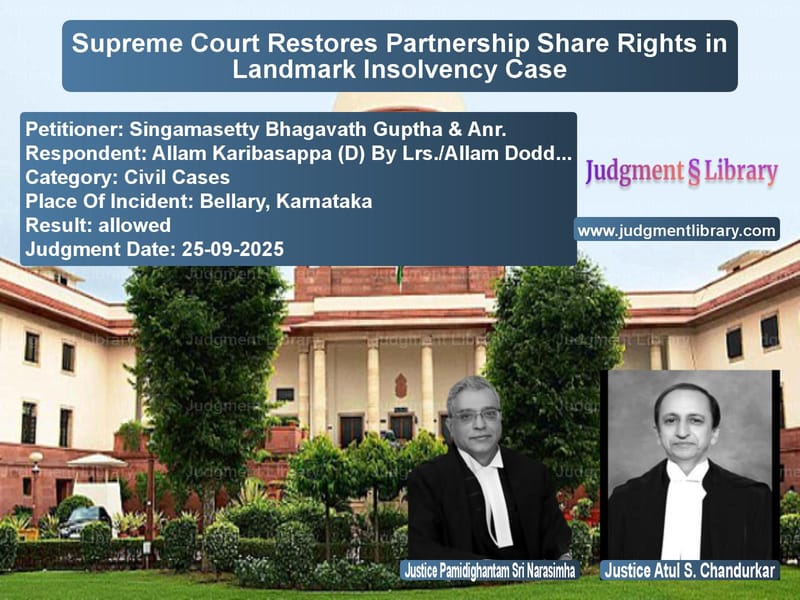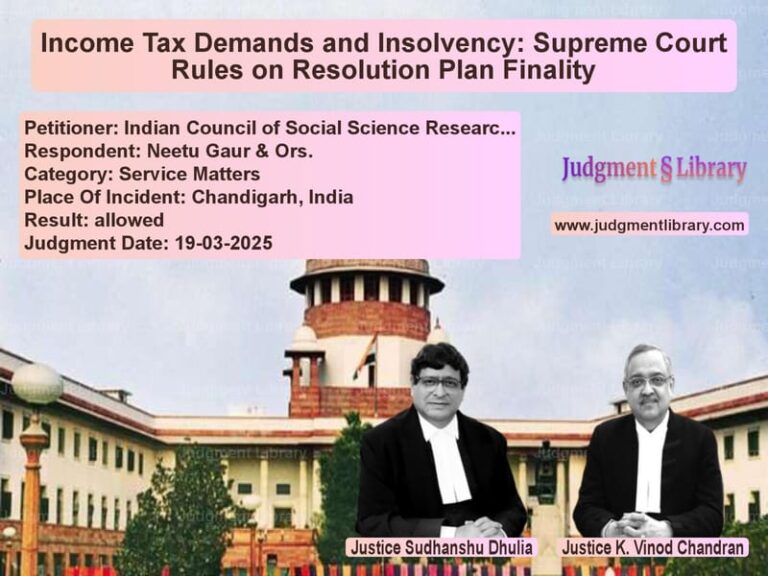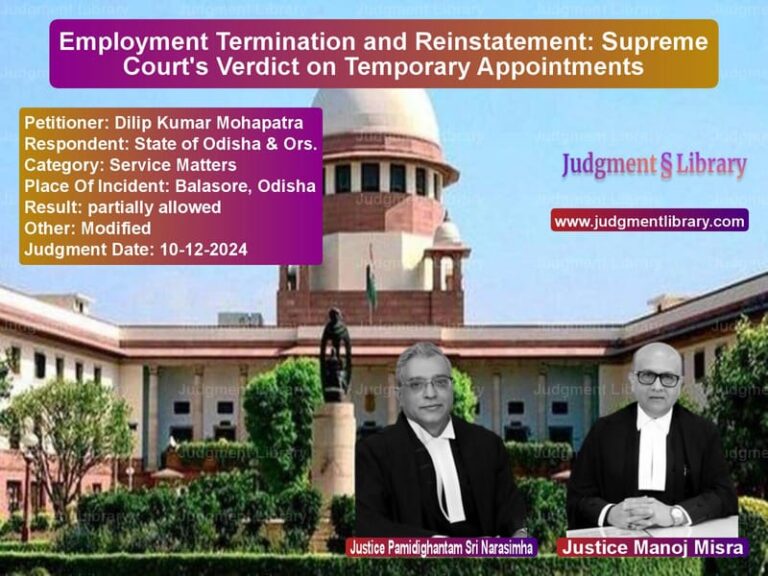Supreme Court Restores Partnership Share Rights in Landmark Insolvency Case
A complex legal battle spanning nearly five decades over partnership shares and insolvency rights reached its conclusion when the Supreme Court delivered a significant judgment restoring property rights that had been caught in the web of insolvency proceedings. The case involved a partnership firm called M/s Gavisiddheshwara & Co., where the shares of a deceased partner became the subject of intense litigation between his heirs and other partners.
The story began in 1963 when the partnership firm was established with late Sri Allam Karibasappa as a major partner holding eight anna share and Agadi Laxminarayana Setty as convenor with five anna share. Three additional partners, including Singamasetty Subbarayudu (father of the present appellant), joined later with one anna share each. The partnership agreement contained a crucial clause that allowed devolution of a partner’s share to other partners as a peremptory right.
Tragedy struck on February 20, 1975, when Singamasetty Subbarayudu passed away, leaving his one anna share to be inherited by his son Singamasetty Bhagavath Guptha (the appellant) and his mother Singamasetty Govindamma. However, the family was facing financial difficulties due to debts owed by the deceased father. During this vulnerable period, the appellant allegedly sent a letter dated March 20, 1975, offering to sell his inherited share to any willing partner.
The respondent, Allam Karibasappa, claimed he accepted this offer through correspondence dated March 25, 1975, and argued that a concluded contract existed for the transfer of the one anna share for approximately Rs. 95,000. However, before this transaction could be formally completed, creditors of the appellant filed insolvency proceedings, and on June 25, 1977, the District Court declared the appellant and his mother insolvent, appointing a receiver to take over their assets.
This is where the legal complexities began to unfold. On August 9, 1977, Karibasappa filed an application before the District Court seeking directions to the receiver to accept Rs. 95,000 and transfer the one anna share in his favor, claiming there was a concluded contract prior to the insolvency declaration. The District Court initially allowed this application on January 4, 1983, and the official receiver executed a transfer deed on March 11, 1983.
However, the appellants challenged this order, and meanwhile, on April 20, 1996, the District Court annulled the insolvency proceedings after finding that the appellants had discharged most of their liabilities to creditors. The court specifically noted that “When the insolvent has shown that he has paid the debt amount, if order of annulment is not passed, much hardship would be caused to the insolvent. Hence, in the interest of justice passing annulment order is necessary.”
On February 13, 1997, the High Court allowed the appeal against the District Court’s 1983 order and remanded the matter back for fresh adjudication. When the case returned to the District Court, it conducted a meticulous analysis of the evidence and made crucial findings that would eventually shape the Supreme Court’s decision.
Read also: https://judgmentlibrary.com/supreme-court-upholds-landowner-rights-in-haryana-bachat-land-case/
The District Court rejected the respondent’s application after finding that the documents purportedly showing offer and acceptance of the share transfer were fabricated. The court noted significant contradictions in these documents and emphasized that the official receiver himself had raised suspicions about their authenticity. The court observed that “the then official receiver about inaction of the original Petitioner No.1 in not coming up with original documents… had made him to doubt about the existence of these documents and apparently he did plead that they were got up documents. This Court reaffirms that apprehension of this official receiver about the fabrication of the said documents were nothing but true.”
Despite these clear findings, the Karnataka High Court, in its impugned judgment dated February 25, 2011, reversed the District Court’s decision. The High Court relied heavily on Section 37 of the Provincial Insolvency Act, 1920, and precedents from the Supreme Court to hold that the transfer deed executed by the official receiver remained valid despite the annulment of insolvency.
The High Court stated that “When the principles laid down by the Hon’ble Supreme Court in the above referred cases are applied to the above said undisputed facts of the case, it is clear that the order of the learned District Judge dated 20.04.1996 annulling his earlier order… would not in any way affect the sale deed dated 11.03.1983 that is executed by the Official Receiver in favour of Allum Karibasappa as the said conveyance is saved as per the principles laid down by the Hon’ble Supreme Court.”
However, the High Court did limit the application of the transfer deed to only the appellant’s half-anna share, noting that there was no evidence that the appellant’s mother had consented to sell her half-anna share.
Before the Supreme Court, the respondents, represented by Mr. Basava Prabhu S. Patil, learned Senior Advocate, argued strongly that the High Court’s decision affirming the legality of the transfer was correct. They relied on Section 37 of the Provincial Insolvency Act and precedents including Babu Ram alias Durga Prasad v. Indra Pal Singh and Arora Enterprises Ltd. v. Indubhushan Obhan.
Mr. Patil emphasized the legal position summarized in Babu Ram’s case: “Summarising the legal position, the position is as follows. In the case of an annulment under Section 37 read with Section 43 of the Act, where the property is not vested in any other person and no conditions are imposed by the Insolvency Court, the property and rights of the insolvent stand restored or reverted to him with retrospective effect from the date of the filing of the insolvency petition and the insolvency gets wiped out altogether. All acts done by the undischarged insolvent between the date of the insolvency petition and the date of annulment get retrospectively validated. However, all sales and dispositions of property and payments duly made and all acts therefore done by the court or Receiver, will remain valid.”
Similarly, in Arora Enterprises, the Court had held that “the effect of annulling the adjudication in insolvency proceedings is to wipe out the effect of insolvency and to vest the property retrospectively in the insolvent. The consequence of annulling an order of adjudication is to wipe out altogether the insolvency and its effect. The property will revest in the insolvent retrospectively from the date of the vesting order.”
The Supreme Court, however, took a different approach. The bench comprising Justice Pamidighantam Sri Narasimha and Justice Atul S. Chandurkar delved into the fundamental requirement of Section 37 – that for transactions to be protected, they must be “duly made.” The Court emphasized that before applying Section 37’s protection, it was essential to examine whether the transactions and orders of the court and receiver were valid and had attained finality.
The Court noted that the High Court had committed a serious error by ignoring that its own earlier order dated February 13, 1997, had set aside the District Court’s 1983 order that formed the basis of the transfer deed. The Supreme Court pointed out that “the High Court committed an error in ignoring the fact that, by virtue of its earlier order dated 13.02.1997, the order dated 04.01.1983 allowing I.A. No. XV was set aside, and I.A. No. XV was remanded for reconsideration. As a consequence, the transfer deed dated 11.03.1983 had no legs to stand.”
More importantly, the Supreme Court criticized the High Court for failing to properly exercise its appellate jurisdiction. The Court noted that the High Court had simply dismissed the District Court’s detailed findings as being based on “surmises and conjectures” without providing any independent analysis of the evidence. The Supreme Court emphasized the duty of an appellate court, particularly when reversing a trial court’s judgment.
Quoting from its earlier decision in Santosh Hazari v. Purushottam Tiwari, the Court reiterated that “The appellate court has jurisdiction to reverse or affirm the findings of the trial court. First appeal is a valuable right of the parties and unless restricted by law, the whole case is therein open for rehearing both on questions of fact and law. The judgment of the appellate court must, therefore, reflect its conscious application of mind and record findings supported by reasons, on all the issues arising along with the contentions put forth, and pressed by the parties for decision of the appellate court.”
The Court further elaborated that “while reversing a finding of fact the appellate court must come into close quarters with the reasoning assigned by the trial court and then assign its own reasons for arriving at a different finding. This would satisfy the court hearing a further appeal that the first appellate court had discharged the duty expected of it.”
The Supreme Court found that the High Court had failed in this essential duty. While the District Court had conducted a thorough analysis of the evidence and found that the documents supporting the share transfer were fabricated, the High Court had simply reversed these findings without adequate reasoning.
The Supreme Court’s judgment reinforces several important legal principles. First, it clarifies that the protection under Section 37 of the Provincial Insolvency Act applies only to transactions that are “duly made” – meaning they must be valid and proper in the first place. Second, it underscores the responsibility of appellate courts to provide detailed reasoning when reversing trial court findings, especially on questions of fact. Third, it highlights that technical legal provisions cannot be used to validate transactions that are fundamentally flawed or based on fabricated evidence.
In its concluding remarks, the Supreme Court stated that “Having considered the matter in detail, we have no hesitation in holding that the High Court committed a serious error in reversing the findings of the District Court in its judgment.” The Court thus allowed the appeals filed by Singamasetty Bhagavath Guptha and restored the District Court’s judgment that had dismissed the application for transfer of the partnership share.
This judgment brings closure to a nearly fifty-year legal battle and serves as an important precedent on the interpretation of insolvency laws, the protection of property rights, and the responsibilities of appellate courts. It demonstrates the judiciary’s commitment to ensuring that legal technicalities do not override substantive justice and that appellate courts must exercise their powers with due diligence and proper reasoning.
Petitioner Name: Singamasetty Bhagavath Guptha & Anr..Respondent Name: Allam Karibasappa (D) By Lrs./Allam Doddabasappa (D) By Lrs. & Ors..Judgment By: Justice Pamidighantam Sri Narasimha, Justice Atul S. Chandurkar.Place Of Incident: Bellary, Karnataka.Judgment Date: 25-09-2025.Result: allowed.
Don’t miss out on the full details! Download the complete judgment in PDF format below and gain valuable insights instantly!
Download Judgment: singamasetty-bhagava-vs-allam-karibasappa-(d-supreme-court-of-india-judgment-dated-25-09-2025.pdf
Directly Download Judgment: Directly download this Judgment
See all petitions in Property Disputes
See all petitions in Debt Recovery
See all petitions in Contract Disputes
See all petitions in Succession and Wills
See all petitions in Damages and Compensation
See all petitions in Judgment by P.S. Narasimha
See all petitions in Judgment by Atul S. Chandurkar
See all petitions in allowed
See all petitions in supreme court of India judgments September 2025
See all petitions in 2025 judgments
See all posts in Civil Cases Category
See all allowed petitions in Civil Cases Category
See all Dismissed petitions in Civil Cases Category
See all partially allowed petitions in Civil Cases Category







